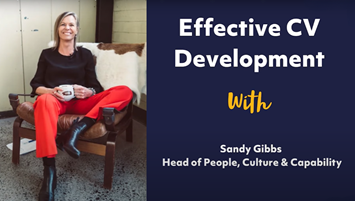Who should write your CV?
ONE ANSWER – You! One of the most valuable things about a CV is the process of writing it.
You know ‘you’ the best! Therefore, you should write it yourself and be able to confidently talk about the content when it comes to interviewing.
It gives you stronger conviction about what you can do and allows you continued control and ownership of all stages of your job search process
The ‘30 Second Test’
The typical job advertisement can generate anywhere between 20 and 100 responses, however in a candidate-rich market or when unemployment rates are high, this can run in to 100s and 100s at some levels.
In the process of reducing that number to a manageable group of qualified applicants, employers will often skim CVs for around 30 seconds, looking for reasons to screen people out. They will put your CV aside – and your prospects for a job with it – if it’s hard to read, difficult to follow or confusing, too long, messy, vague, and has mistakes.
In a competitive market, this 30 second window can shrink by half, especially when it’s in the hands of someone who is time-poor.
What CV readers look for
People who read CVs can judge both on the content you provide about yourself and on how you present that information. Both content and presentation say something about you and how serious you are about your job search.
The content of your CV is not intended to tell them absolutely everything. It’s to provide employers with the information they need to determine whether you could be a good fit for the job – creating interest in you.
A good CV tells a story – it needs to be compelling.
A CV should convince the reader you deserve an interview. Many CV formats are acceptable, but one thing is essential:
Your CV must be easy to read!
You need to let the reader find out both quickly and easily, what you’ve done, where you have done it, why, and the outcomes you’ve achieved.
Developing your CV
The look can be personalised, but keep it simple. Content, framework of how to deliver the message, and placement are all core fundamentals.
Within every section of your CV follow the rule latest at the top, oldest at the bottom.
Snapshot of components:
- Personal/contact information (best in a header or footer format)
- Education (degrees/diplomas)
- Career overview (full career – ideally in an easy to read tabbed form or table)
- Career achievements/highlights (your sales pitch)
- Position details/role responsibilities (five to seven years or two to three positions)
- Summary of core business skills (optional)
- Additional training courses
- Memberships/committees/volunteer responsibilities
- Personal interests (optional)
- Referees
Tips and reminders
Do
- It’s a sales document, so sell yourself - if you can’t do this, no one else can
- Write it yourself
- Make it about your career. If another candidate could write your CV, think again. It needs to be specific to your experience and your outcomes e.g. “Sandy-fy” it!
- Make it easy for the reader
- Use fact and substantiated statements – including results and outcomes
- Use numbers, figures – they draw the eye and interest
- A CV is a career overview – so include your career, not just a chapter
Don’t
- Include anything that allows for personal judgement
- Include photos (as above)
- Assume who the reader is!
- Don’t have someone else write your resume – you need to own it, and be able to talk to it confidently at interview (get guidance and help, but compile it yourself)
- Don’t talk about the “how” – that is where waffle will kick in. The CV is to intrigue and excite the reader, so they will want to know more – save the “how”, if needed, for interviews
- Don’t use motherhood statements or subjective statements eg. strong relationship builder and business development skills (says who?); Excellent people manager (says who?); Strategic thinker (says who?); Multi-channel sales capability (what channels, how many and where?)
- Mention participation in high-risk activities
- Use abbreviations, “shoptalk” and jargon as you can’t be sure the reader will know what they mean - translate industry or specialised words into general business terms or concepts
- Don’t blur what you were employed to do in a role e.g. role responsibilities versus achievements – it’s a common mistake
- Make it look fussy by using visual “tricks” or overcomplicate it with colour and design – it can detract from the content
- Mention salary information in a CV
- Mention commercially sensitive information
How many CVs do you really need?
ONE! It’s about your whole story if you have written it well. The parts you may have opted to take out or assumed were not important nor of interest could have:
- Set you apart from others
- Been of interest to another area of the business
You can also risk sending the wrong one – we’ve seen it happen time and time again! The less confusing you make this process, the better. Specific detail, relating to the advert can be highlighted in a succinct cover letter.
The role of the humble cover letter
This is where you draw attention to key things and extend on items specific to the advert, which will complement your CV. It’s not a repeat of your CV and it should be a short and succinct response to the advert. Less is more!
Make each application count by personalising each cover letter and updating and proofreading your resume. Many people send applications with a generic letter because speed has been the focus. If there is a name – use it. If there are job details highlighted – refer to them.





